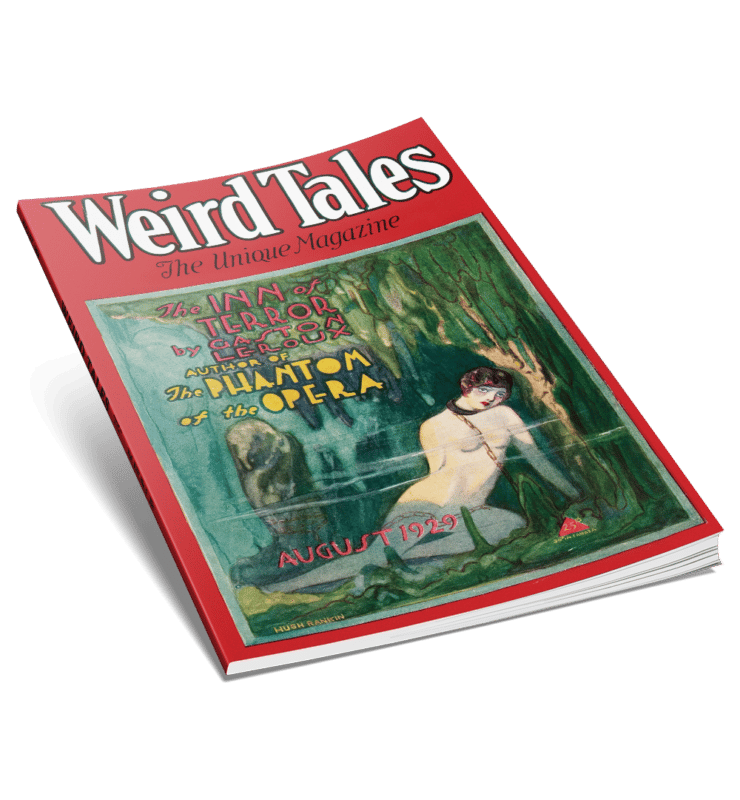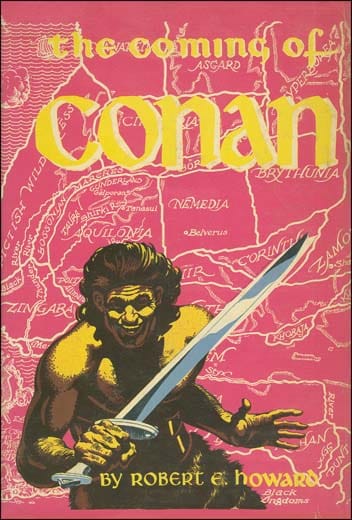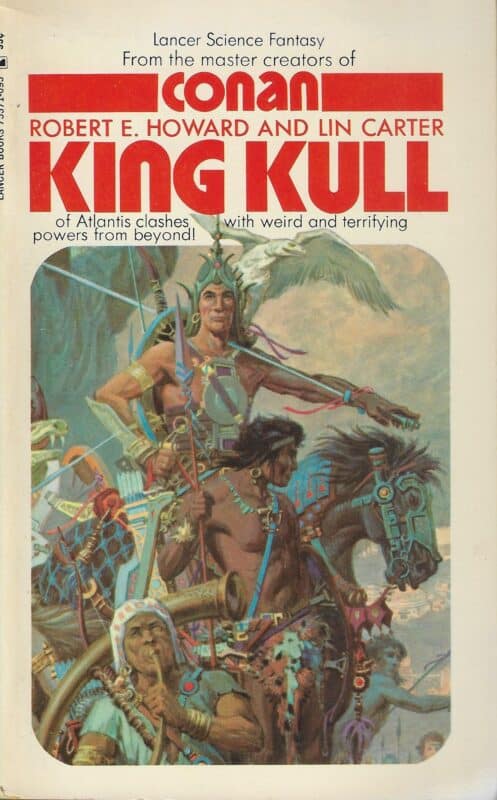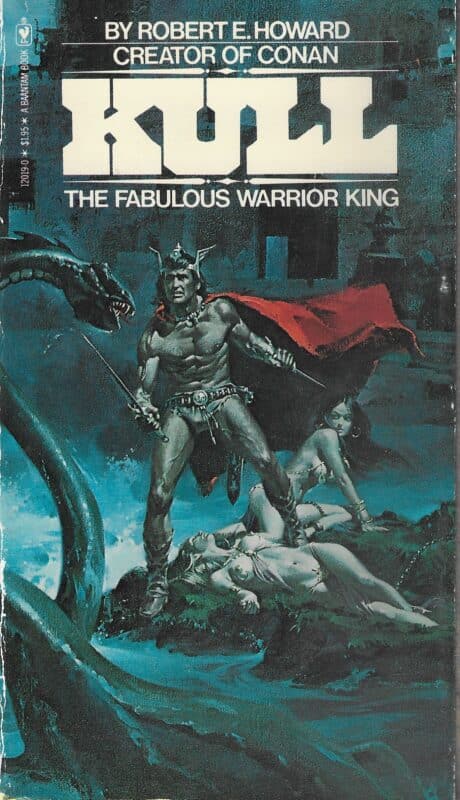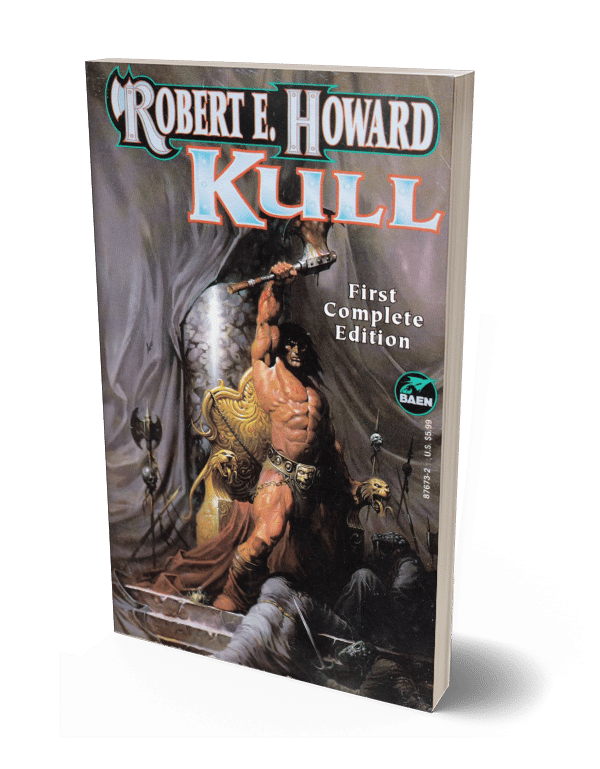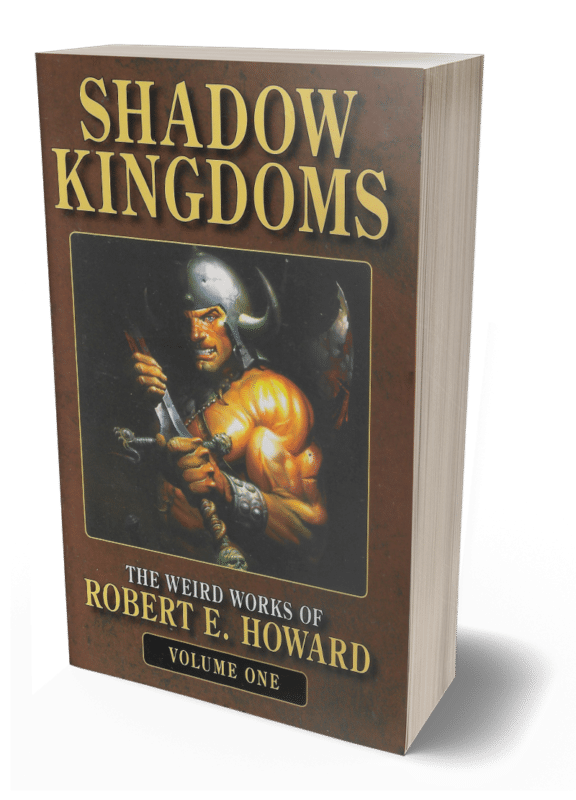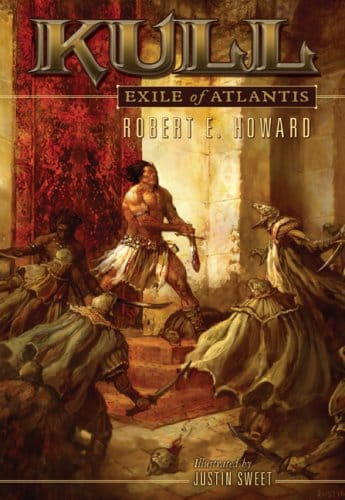Introduction
“The Shadow Kingdom”, the first of his Kull stories, is set in his fictional Thurian Age. It was first published in the pulp magazine Weird Tales in August 1929. Howard got $100 for the story.
Howard completed this in the summer of 1927 and laid it aside. In the late summer, he rewrote it and laid it aside again.
The first we learn of the story from the letters is when he wrote Tevis Clyde Smith, circa mid- to late-September 1927 (letter #054):
P. S. Since writing you that other letter I’ve sold another mss. I got a hundred dollars for it; that is, I am to get it on publication. I don’t know when it will be published or whether you’ll like it or not. I enjoyed writing it more than any piece of prose I ever wrote. The subject of psychology is the one I am mainly interested in these days. The story I sold before this3 was purely a study in psychology of dreams and this ms. deals largely in primitive psychology. I don’t know whether they’ll publish it as a serial or as a “complete novel.”
The first story mentioned is “The Shadow Kingdom”, the second is “The Dream Snake”.
Howard mentions the story in a letter (#086) to Harold Preece, dated October 20th, 1928:
All my views on the matter I included in a long letter to the editor to whom I sold a tale entitled “The Shadow Kingdom,” which I expect will be published as a foreword to that story — if ever. This tale I wove about a mythical antediluvian empire, a contemporary of Atlantis.
Howard mentions the story in a letter (#107) to Tevis Clyde Smith, circa April 1929.
Farnsworth said he intended publishing a sonnet in the next issue after that and then “The Shadow Kingdom” which is a $100 story, and after that a shorter story.
He mentioned it again in a letter (#123) from circa March 1930:
I received a letter from Farnsworth today accepting my “Kings of the Night” — $120, on publication of course. I rather expected him to take it for the new magazine, as it’s full of action but has no really weird touches. However he accepted it for Weird Tales; possibly because the central figure is Kull of Atlantis, featured in “The Shadow Kingdom” and “The Mirrors of Tuzun Thune.” It was rather a new line for me, as I described a pitched battle.
and again to Harold Preece in a letter (#144) in October or early November 1930:
But to return to the Mediterraneans of the Isles, where these tribes remained a race apart longer than anywhere else. These aborigines are popularly known as Picts, and by this name I have designated them in all my stories — and I have written a number in which I mentioned or referred to them — “The Lost Race,” “The Shadow Kingdom,” “The Mirrors of Tuzun Thune,” “The Dark Man,” “Kings of the Night,” to say nothing of several which I have not marketed.
On February 20th, 1933 Howard wrote (letter #235) to Mr. August Lenninger regarding ‘The Shadow Kingdom’:
Dear Mr. Lenniger:
Here are the copies of “The Shadow Kingdom.” I assume that you have arranged with Weird Tales for the reprint rights. That magazine owns all rights to the story. Please let me know by return mail what arrangements you have made with the magazine company. I enclose a stamped envelope for your convenience.
E. Hoffmann Price wrote Howard telling him that he and Mashburn were attempting to promote a sort of anthology of weird tales (see letter #173).
Howard later informs Mr. Lanninger that he has permission to allow the story to be published in the proposed anthology (letter #239):
This is to inform you that I have the permission of Weird Tales to allow “The Shadow Kingdom” to be published in the proposed anthology.
Lovecraft commented on Howard’s Kull stories (this letter does no longer exist) and in a letter (#294) Howard says:
Thanks for the kind things you said about the Kull stories, but I doubt if I’ll ever be able to write another. The three stories I wrote about that character seemed almost to write themselves, without any planning on my part; there was no conscious effort on my part to work them up. They simply grew up, unsummoned, full grown in my mind and flowed out on paper from my fingertips. To sit down and consciously try to write another story on that order would be to produce something the artificiality of which would be apparent.
Howard is acknowledging only the three stories published in Weird Tales: “The Shadow Kingdom,” August 1927; “The Mirrors of Tuzun Thune,” September 1927; and “Kings of the Night,” November 1930.
This story is also referred to after Howard’s death, in Fantasy Magazine, September 1936 in their ‘In Memoriam’:
Always a keen student of Celtic antiquities and other phases of remote history, Mr. Howard began in 1929—with “The Shadow Kingdom,” in the August Weird Tales—that succession of tales of the prehistoric world for which he soon grew so famous.
And E. Hoffmann Price brings the story up in his ‘Diablerie’ from May 1944 about Robert E. Howard:
Howard lived in a realm of wonder and fantasy. After hearing my reasons for considering certain early yarns, such as “Kings of the Night,” “Mirrors of Tuzun Thune,” “Shadow Kingdom,” and the “Brule the Spear Slayer” epoch, far superior to the Conan series, he agreed and said, “I dreamed them, so they’re naturally more realistic than those I deliberately wrote.”
He does the same for The Ghost, published in May 1945 by W. Paul Cook.
This can’t be the man who wrote “The Shadow Kingdom,” or “Kings of the Night,” this can’t be the man who composed the tremendous lines at the climax of “Sowers of the Thunder”: poetry in the form of prose, and with all the ring of Elizabethan drama.
Story intro
The story introduces Kull himself, the setting of Valusia, Brule the Spear-Slayer (a supporting character), and the Serpent Men (who don’t appear in any other work by Howard but were adopted by later authors for derivative works and inclusion in the Cthulhu Mythos).
Kull – also known as King Kull, Kull of Atlantis, Kull the Conqueror is a fictional character created by Robert E. Howard. His first published appearance was The Shadow Kingdom, in Weird Tales (August 1929).
Voted best story by the fans in original Weird Tales appearance, with one of the 50 highest totals ever.
Plot/summary
A King Comes Riding
The story begins with a grand procession in Valusia. King Kull, the Atlantean warrior who has claimed the throne, leads his formidable army through the streets, receiving both cheers and murmurs of disapproval from the populace. Despite the mixed reactions, Kull remains undeterred, embodying the strength and resolve of a true warrior king.
Kull, reflecting on his rise to power, is approached by an emissary from the Pictish embassy who delivers a message from Ka-nu, the chief of the Councilors. Ka-nu invites Kull to a secret meeting, hinting at matters of great importance that cannot be discussed in the open. Suspicious but intrigued, Kull agrees to the meeting, setting the stage for the unfolding conspiracy.
Thus Spake the Silent Halls of Valusia
Kull arrives at Ka-nu’s banquet, where the atmosphere is relaxed and informal, a stark contrast to the stiff formalities of the Valusian court. Ka-nu, an ancient and shrewd statesman, reveals that the kingdom is under threat from an insidious plot by the serpent-men, shape-shifting creatures who can assume human form. He warns Kull that these snake-people are embedded deep within Valusia’s power structures and have already replaced key figures, including some of Kull’s own councilors.
Ka-nu urges Kull to trust Brule, the Spearslayer, a Pictish warrior who will guide him through the coming dangers. The old statesman also shows Kull a stolen gem from the Temple of the Serpent, symbolizing the depth of the threat they face. Kull is left to ponder the gravity of the situation and the ancient enmities and alliances that shape his rule.
They That Walk the Night
As night falls, Kull finds himself unable to sleep, haunted by the revelations of Ka-nu. Brule sneaks into the palace through a secret passage, revealing more about the serpent-men’s plot. He leads Kull through hidden corridors, showing him the slain bodies of his guards, replaced by serpent-men who now guard his chambers. Kull is horrified but determined to confront the threat head-on.
The two warriors discover Tu, the chief councilor, attempting to assassinate Kull. In a swift and deadly encounter, Kull slays Tu, only to see his face transform into that of a serpent. This confirms the extent of the infiltration and the supernatural nature of their enemies.
Masks
The next day, Kull presides over the court, his mind heavy with the knowledge of the hidden threats. The serpent-men’s deception is palpable, and he sees the faces of his councilors as potential masks for the serpentine invaders. Brule remains by his side, a steadfast ally in the face of the unknown.
During a council meeting, Kull and Brule confront the serpent-men who have disguised themselves as councilors. A fierce battle ensues, with Kull and Brule fighting side by side against the monstrous foes. Despite their ferocity, the serpent-men are eventually defeated, revealing their true forms in death.
Kull and Brule then face a final deception. They find themselves in a room with an impostor Kull addressing the council. The real Kull acts swiftly, killing the impostor and revealing the serpent’s true form to the stunned councilors. Exhausted and wounded, Kull makes a vow to hunt down every serpent-man and ensure the safety and prosperity of Valusia.
Characters
- Kull: King of Valusia, an Atlantean warrior who has seized the throne. A formidable leader, grappling with the insidious threat of the serpent-men.
- Brule the Spearslayer: A Pictish warrior, loyal ally to Kull, and key figure in uncovering the serpent-men’s conspiracy.
- Ka-nu: Chief of the Councilors, a wise and shrewd Pictish statesman who warns Kull about the serpent-men and advises him to trust Brule.
- Tu: Chief councilor of Valusia, revealed to be a serpent-man in disguise, who attempts to assassinate Kull.
- The Serpent-Men: Shape-shifting creatures who can assume human form, infiltrating the highest levels of Valusia’s power structures in a plot to overthrow Kull.
Published in
- WEIRD TALES VOLUME 14 NUMBER 2, Popular Fiction Publishing Company, August 1929
- SKULL-FACE AND OTHERS, Arkham House, 1946
- THE COMING OF CONAN, Gnome Press, 1953 (edited by LSDC)
- KING KULL, Lancer, 1st, 1967 (edited by Lin Carter)
- LANDS OF WONDER – PIONEER #26, Austrotopia, June 1968 (German)
- DE ZWARTE STEEN (THE BLACK STONE), Zwarte Beertjes, 1969 (Dutch)
- KING KULL, Lancer, 2nd, 1969
- KULL THE CONQUEROR VOLUME 1 NUMBER 2, Marvel Comics, September 1971 (graphic adaptation)
- KING KULL, Lancer, 3rd, 1972
- KULL, Follow (Fellowship of the Lords of the Lands of Wonder), 1974 (German)
- SKULL-FACE OMNIBUS, Neville Spearman, 1974
- KULL AND THE BARBARIANS #1, Marvel Comics, May 1975 (graphic adaptation)
- KULL DI VALUSIA, Editrice Nord, September 1975 (Italian)
- SKULL-FACE OMNIBUS, Neville Spearman, 1975
- TERRA FANTASY 28: KULL VON ATLANTIS, Erich Pabel Verlag KG, November 1976 (German)
- SKULL-FACE OMNIBUS, Volume 3, Panther, 1976
- KING KULL, Sphere, 1976
- KULL, Bantam, September 1978
- TERRA FANTASY 28: KULL VON ATLANTIS, Erich Pabel Verlag KG, July 1979 (German, 2nd printing)
- KULL LE ROI BARBARE, NeO, 1st Quarter 1980 (French)
- KULL LE ROI BARBARE, NeO, May 1983 (French, 2nd printing)
- FANTASTYKA 09 (24) 1984, RSW Prasa-Książka-Ruch, September 1984 (Polish)
- ウィアード・テールズ2 ( WIĀDO TĒRUZU 2) (WEIRD TALES 2 [1930-1934]), Kokusho Kankohkai, September 1984 (Japanese)
- KULL LE ROI BARBARE, NeO, September 1984 (French, 3rd printing)
- KULL LE ROI BARBARE, Euredif, October 1984 (French)
- KULL, Grant, 1985 (Regular edition)
- KULL, Grant, 1985 (Limited edition)
- EL REINO DE LAS SOMBRAS, Ediciones Obelisco, 1987 (Spanish)
- ISAAC ASIMOV’S MAGICAL WORLDS OF FANTASY #9: ATLANTIS, Signet, January 1988
- KULL LE ROI BARBARE, NeO, April 1988 (French, 4th printing)
- WEIRD TALES: 32 UNEARTHED TALES, Bonanza Books, 1988
- KULL VON ATLANTIS, Bastei Verlag, March 1989 (German)
- ROBERT E. HOWARD’S WORLD OF HEROES, Robinson, 1989
- THE SAVAGE SWORD OF CONAN VOLUME 1 NUMBER 177, Marvel Comics, September 1990 (brief excerpt only)
- SVATYNĔ ODPORNOSTI A JINÉ POVÍDKY, Laser Books, 1990 (Czech)
- KRÁL KULL, Arla, 1991 (Czech)
- KULL LE ROI BARBARE, Fleuve Noir, January 1992 (French)
- ÁRNYKIRÁLYOK, Cherubion Könyvkiadó, 1992 (Hungarian)
- YÖN KUNINKAAT, WSOY, 1992 (Finnish)
- KULL DI VALUSIA, Editrice Nord, October 1993 (Italian)
- LHORK 7 (LHORK EXTRA 4 ESPECIAL TERROR), Círculo de Lhork, 1993 (Spanish, Part 2)
- REY KULL, Ediciones Martinez Roca, 1993 (Spanish)
- KULL, Wydawnictwo Andor, 1994 (Polish)
- TUTTI I CICLI FANTASTICI: I CICLI DI KULL DI VALUSIA, DI JAMES ALLISON, DI CTHULHU E DI ALMURIC, Newton Compton Editori, April 1995 (Italian)
- KULL, Baen, July 1995 (restored text)
- ATLANTIDES, LES ÎLES ENGLOUTIES, Presses de la Cité, 1995 (French)
- KRÁL KULL, Kunder Publishing, 1997 (Slovak)
- ЦАРь КУЛЛ (TSAR KULL / KING KULL), Азбука-Терра (Azbuka-Terra / ABC-Terra), 1997 (Russian)
- SVATYNĔ ODPORNOSTI, Laser Books, 1999 (Czech)
- KULL, Laser Books, 2000 (Czech)
- ATLANTIDES, LES ÎLES ENGLOUTIES, Presses de la Cite, January 2001 (French, second printing)
- NAMELESS CULTS, Chaosium, December 2001
- SHADOW KINGDOMS, Wildside Press, December 2004
- SHADOW KINGDOMS, Wildside Press, November 2005
- THE WEIRD WRITINGS OF ROBERT E. HOWARD Volume 1, Girasol Collectables, January 2006
- KULL: EXILE OF ATLANTIS, Del Rey, October 2006
- KULL: EXILE OF ATLANTIS, Science Fiction Book Club, November 2006
- SHADOW KINGDOMS, Wildside Press, November 2006 (2nd printing)
- SHADOW KINGDOMS: THE WEIRD WORKS OF ROBERT E. HOWARD Volume 1, Audio Realms, April 2007, (audio)
- SHADOW KINGDOMS, Cosmos Books, July 2007
- CRIMSON SHADOWS: THE BEST OF ROBERT E. HOWARD VOLUME 1, Del Rey, August 2007
- MITRANIA NR. 3 2007, Mitrania, 2007 (Swedish)
- THE SHADOW KINGDOM, Dodo Press, February 2008
- KULL. ESULE DI ATLANTIDE, Arnoldo Mondadori Editore, April 2008 (Italian)
- KULL: EXILE OF ATLANTIS, Subterranean Press, August 2008
- KUNINGAS KULL JA BRAN MAK MORN, Fantaasia, 2008 (Estonian)
- HEROES IN THE WIND: FROM KULL TO CONAN, Penguin Books, September 2009
- CRIMSON SHADOWS: THE BEST OF ROBERT E. HOWARD VOLUME 1, Subterranean Press, November 2009
- THE CHRONICLES OF KULL Volume 1, Dark Horse Books, December 2009 (Graphic adaptation)
- THE KULL SERIES: THE SHADOW KINGDOM, Paradox Entertainment Inc., January 2010
- THE SHADOW KINGDOM AND OTHER WORKS, Halcyon Press, Ltd., January 2010
- KULL: EXILE OF ATLANTIS, Tantor Media Inc., January 2010 (audio)
- THE ROBERT E. HOWARD OMNIBUS: 99 COLLECTED STORIES, Halcyon Press, Ltd., May 2010
- KULL LE ROI ATLANTE, Bragelonne, July 2010 (French)
- CONAN’S BRETHREN, Gollancz, January 2011
- THE SHADOW KINGDOM AND OTHER TALES, Benediction Classics, August 2011
- THE KULL SERIES: THE SHADOW KINGDOM, Paradox Entertainment Inc., November 2011
- KUNINGAS KULL JA BRAN MAK MORN, Fantaasia, 2011 (Estonian)
- O REINO DAS SOMBRAS, Clube de Autores, 2011 (Portuguese)
- DAYS OF HIGH ADVENTURE, Schlock! Publications, March 2012 (UK)
- KULL OF ATLANTIS AND OTHER STORIES, Jame-Books, August 2012
- KULL KIRÁLY ÉS AZ ŐSÖK, Delta Vision Kft., August 2012 (Hungarian)
- SKULLCRUSHER: SELECTED WEIRD FICTION VOLUME 1, Creation Oneiros, September 2012
- KULL KIRÁLY ÉS AZ ŐSÖK, Delta Vision Kft., November 2012 (Hungarian)
- KRÓLESTWO CIENI I INNE OPOWIADANIA Z MITOLOGII CTHULHU, Agharta, January 2013 (Polish)
- ROBERT E. HOWARD’S COLLECTED WORKS, Jame-Books, February 2013
- DER SCHWARZE HUND DES TODES, Festa Verlag, June 2013 (German)
- KULL: BANITA Z ATLANTYDY, Rebis, February 2014 (Polish)
- БРАН МАК МОРН, ПОСЛЕДНИЙ КОРОЛЬ. КУЛЛ, ВЫХОДЕЦ ИЗ АТЛАНТИДЫ (BRAN MAK MORN: THE LAST KING. KULL: NATIVE OF ATLANTIS), Eksmo, May 2014 (Russian)
- THE SAGA OF KING KULL & THE HISTORICAL ADVENTURES, Business and Leadership Publishing, July 2014
- THE SHADOW KINGDOM AND OTHER WEIRD TALES, Ulwencreutz Media, October 2015
- O MUNDO SOMBRIO: HISTÓRIAS DOS MITOS DE CTHULHU, Editora Clock Tower, March 2016 (Portuguese)
- KULL OF ATLANTIS, Ozymandias Press, June 2016
- KULL OF ATLANTIS, Jovian Press, October 2016
- O REINO DAS SOMBRAS, Red Dragon Books, May 2017 (Portuguese)
- ROBERT E. HOWARD’S CONAN THE CIMMERIAN BARBARIAN: THE COMPLETE WEIRD TALES OMNIBUS, Pulp-Lit Press, June 2017
- ROBERT E. HOWARD’S CONAN THE CIMMERIAN BARBARIAN: THE COMPLETE WEIRD TALES OMNIBUS, Audible Audio, June 2017
- HEROIC FANTASY SHORT STORIES, Flame Tree Publishing, September 2017
- SCIENCE FICTION AND FANTASY SHORT STORIES, Arcturus Publishing, November 2017
- ROBERT E. HOWARD’S CONAN THE CIMMERIAN BARBARIAN: THE COMPLETE WEIRD TALES OMNIBUS, Easton Press, 2017
- SCIENCE FICTION AND FANTASY SHORT STORIES, Arcturus Publishing, April 2018
- A ROBERT E. HOWARD SAMPLER, Robert Derie & Chris Gruber, June 2018
- SLAVE, SOLDIER, AND KING, Apollyon Press, August 2018
- THE BIG BOOK OF CLASSIC FANTASY, Vintage Books, July 2019
- STORIES OF SHAPE-SHIFTING, Hjem House, February 2020
- LE ROYAUME DES CHIMÈRES, Le Livre de Poche, April 2020 (French)
- KULL LE ROI ATLANTE, L’INTÉGRALE, Bragelonne, June 2020 (French)
- KULL DI VALUSIA, GM Libri, July 2020 (Italian)
- KULL DI VALUSIA. IL CICLO COMPLETO, Fanucci Editore, September 2020 (Italian)
- THE CTHULHU STORIES OF ROBERT E. HOWARD, WordFire Press, September 2020


